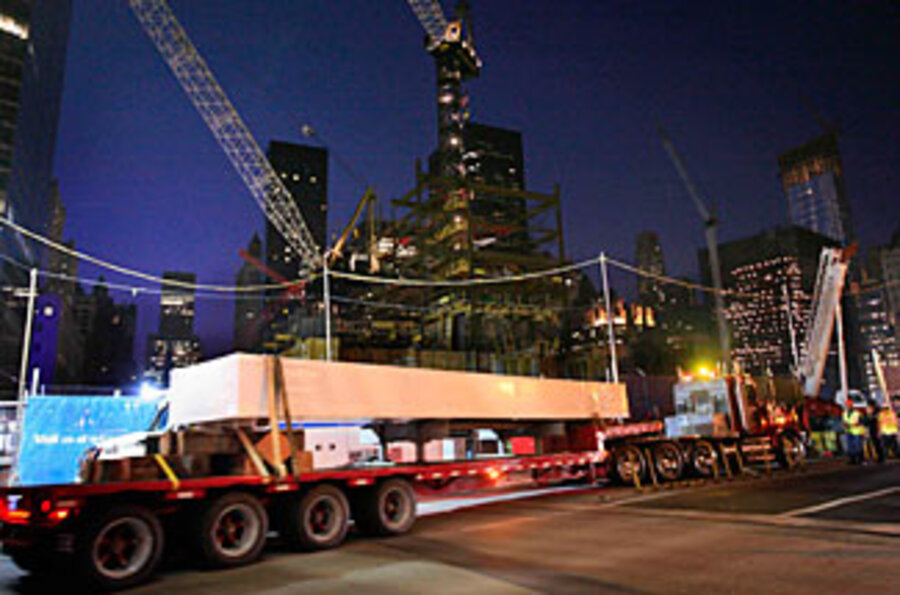World Trade Center's steel beam to be part of 9/11 memorial
Loading...
| New York
New York City struck its first notes of memorial solemnity this week, returning an icon of the 9/11 attacks to ground zero.
The last piece of steel standing after two hijacked airplanes struck and felled the World Trade Center towers was returned to the site – as a piece of what will be the National September 11 Memorial & Museum.
The 36-foot-long fragment of the South Tower has become known to locals as "the last column." Once part of a steel box that ran from the bedrock to the roof of the 1,300-foot-tall tower, the last column became an impromptu memorial site, where emergency responders and family members duct-taped pictures of lost loved ones, notes, and Mass cards.
It was also the last piece of the towers to be removed, and its extraction in 2002 marked the end of a nine-month effort to recover the remains of the nearly 3,000 victims.
"The last column is one of the most iconic artifacts that still exists today," says Joe Daniels, president of the memorial and museum. The column is "the first artifact symbolizing the recovery effort and sacrifices that were made."
The column was brought back to the city from a hangar at the John F. Kennedy Airport, with a six-car escort. Port Authority Police Lt. John Ryan, who led the escort on its 90-minute trip, said the column's return marks a new chapter in remembering 9/11.
"I viewed it as a positive thing, in that it represents the future and the fact that work is progressing, and in the not too distant future, there'll be a fitting memorial to everybody that was lost," says Lieutenant Ryan.
Ryan worked as a team leader for the recovery effort and remembers the ceremony with which the column was removed on May 30, 2002. On what locals called "the final day," the column was draped in black bunting, adorned with an American flag, and driven to the airport hangar. People lined up along every piece of the roughly 20-mile route, Ryan recalls.
"It mirrored what we did every time we recovered remains," Ryan says. "We would have everybody line up, there'd be an honor guard, and the remains would be … escorted from the site to the morgue."
The steel beam was returned without as much ceremony. It made the journey back to Manhattan at 3:30 a.m., to avoid disrupting traffic.
The memorial and museum is scheduled to open in 2011, on the 10th anniversary of the attacks. The future of ground zero has long been a controversial topic, and planned commercial space, including a 1,776-foot-high "Freedom Tower," proceeds slowly.
That makes the return of the column an important symbol of something else: literal progress, says Mr. Daniels. The memorial and museum will build its roof on top of the column.
Its return this week, Daniels says, shows that "construction is moving forward so rapidly." The memorial site has also laid concrete for its North Tower memorial pool, a reflecting pool that will mark where the first tower stood. And the "survivor's stair case," a set of stairs that connected the World Trade Center plaza with Vesey Street, a route by which many of the survivors found their escape, has been returned.
The column will be among the last artifacts visitors to the museum will see. Lodged once again in the site's bedrock, the column rests in front of the slurry wall, which held back the waters of the Hudson River as the towers collapsed. "Both of those are real symbols of strength and resilience," says Daniels.
That's the message not just of the memorial and museum, but of the memory of the event on Friday, a memory in which Daniels sees a subtle shift.
"There's a certain amount of natural evolution to grief," he says. "We are eight years later, so I think that certainly every anniversary the focus rightly is on the individual, the 2,982 individuals killed. But we've also seen really some positive memories emerging." Daniels cites President Obama's decision to declare Sept. 11 a national day of service this year.
"It's not just about the tragedy of what happened on that day," he says, "but also remembrance of how the country and the world really came together in support of one another and the aftermath."
---
Follow us on Twitter.





